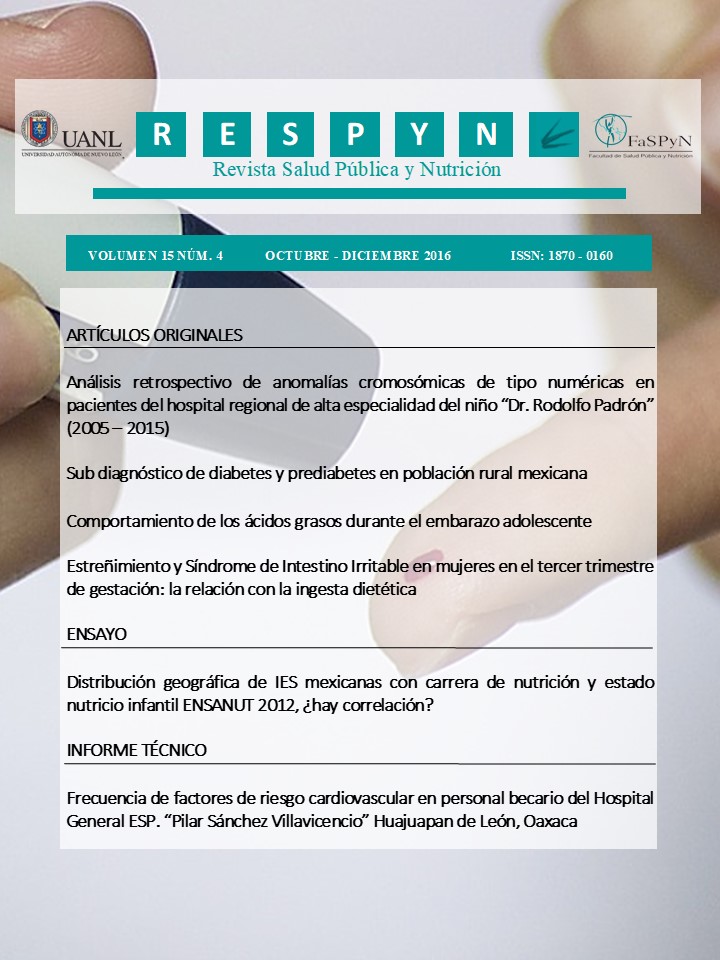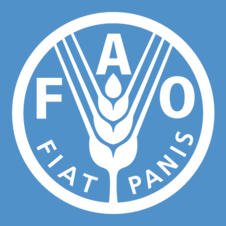FRECUENCIA DE FACTORES DE RIESGO CARDIOVASCULAR EN PERSONAL BECARIO DEL HOSPITAL GENERAL ESP. “PILAR SÁNCHEZ VILLAVICENCIO” HUAJUAPAN DE LEÓN, OAXACA.
Abstract
Introducción: Las enfermedades cardiovasculares (ECV) son la principal causa de muerte en México y en el mundo. Estas enfermedades están relacionadas con factores de riesgo de tipo cardiovascular (FRCV), como la edad, sexo, herencia genética, ingesta de tabaco, alcohol, actividad física, dietas inadecuadas, aumento del índice de masa corporal (IMC) e índice cintura cadera (ICC), presión arterial, colesterol, triglicéridos y glucosa. Objetivo: Determinar la frecuencia de los FRCV en el personal becario del Hospital General ESP. “Pilar Sánchez Villavicencio” en Huajuapan de León, Oaxaca. Métodos: Se realizó un estudio descriptivo de corte transversal, universo de estudio fue el personal becario del Hospital, Las variables antropométricas fueron: índice de masa corporal (IMC) (peso/ talla2), circunferencia de cintura e índice cintura/cadera (ICC). Las variables bioquímicas fueron: glucosa sanguínea, CT y TG totales, Variables conductuales: el consumo de tabaco, consumo de alcohol y actividad física, las muestras se tomaron en el laboratorio clínico del hospital, se consideraron los puntos de corte estipulados por la NOM-015-SSA2-2010 y NOM-037-SSA2-2012. Resultados: el 51.6% presentaron sobrepeso y obesidad (12.9%), la distribución de grasa fue principalmente de tipo androide (64.5%). Se identificó hipertrigliceridemia (35.5%) e hipercolesterolemia (25.8%) en hombres. El 36.4% de los hombres fueron fumadores frecuentes. El 48.38% de la muestra indicó consumir alcohol, el 67.7% no realiza actividad física. Conclusiones: De acuerdo a estos resultados el IMC, ICC, triglicéridos, colesterol y disminución en la actividad física son FRCV frecuentes para la generación de ECV en esta población. Aunado a esto el consumo de alcohol en hombres incrementa mayormente el riesgo de un ECV.
Introduction: Cardiovascular diseases (CVD) are the leading cause of death in Mexico and the world. These diseases are related to cardiovascular risk factors such as age, gender, genetic inheritance, tobacco intake, alcohol, physical activity, inadequate diets, increased body mass index (BMI), and waist circumference (CHF), blood pressure, cholesterol, triglycerides and glucose. Objectives: To determine the frequency of CVRF in the staff of the ESP General Hospital. "Pilar Sánchez Villavicencio" in Huajuapan de León, Oaxaca. Methods: A descriptive cross-sectional study was carried out, the study population being the Hospital staff. The anthropometric variables were body mass index (BMI) (weight / height2), waist circumference and waist / hip ratio (ICC). The biochemical variables were: blood glucose, total TG and TG, Behavioral variables: tobacco consumption, alcohol consumption and physical activity, blood samples were taken in the clinical laboratory of the hospital, the cut-off points stipulated by NOM- 015-SSA2-2010 and NOM-037-SSA2-2012. Results: 51.6% were overweight and obese (12.9%), the fat distribution was mainly of the android type (64.5%). Hypertriglyceridemia (35.5%) and hypercholesterolaemia (25.8%) were identified in men. 36.4% of the men were frequent smokers. 48.38% of the sample indicated consuming alcohol, 67.7% did not perform physical activity.
Palabras Clave: Factores, Riesgo, Cardiovascular, Adulto Joven, Factors, Risk, Cardiovascular, Young Adult
Downloads
References
Aráuz, A., Guzmán, S., Roselló, M. (2013). La circunferencia abdominal como indicador de riesgo de enfermedad cardiovascular. Acta Médica Costarricense. 55(3):122-127.
Aristizábal, O. (2005). Beneficios de la actividad física en la enfermedad cardiovascular. Red de Revistas Científicas de América Latina, el Caribe, España y Portugal. 10: 33-41.
Arráiz, N., Benitez, B., Amell, A., Rangel, L., Carrillo, M., Mujica, A., Mujica, E., Chacín, M., Añez, R., Torres, Y., Salazar, J., Toledo, A., Bermúdez, V. (2011). Hipercolesterolemia y otros factores de riesgo cardiovascular en estudiantes universitarios como estrategia de prevención primaria. Revista Latinoamericana de Hipertensión. 6(1):8-13.
Chacín, M., Rojas, J., Pineda, C., Rodríguez, D., Núñez, M., y Márquez, G. (2011). Predisposición humana a la Obesidad, Síndrome Metabólico y Diabetes: El genotipo ahorrador y la incorporación de los diabetogenes al genoma humano desde la Antropología Biológica. Síndrome cardiometabólico. 1(2):11-25.
Contreras, E., Guillero, L., Zuluaga, S., Ocampo, V. (2008) Diabetes y embarazo. Revista Colombiana de Obstetricia y Ginecolgía. 59(13):38-45.
De la Cuesta, R., Franco, C, Iglesias, E. (2011). Actualización en anticoncepción hormonal. Información Terapéutica del Sistema Nacional de Salud. 35(2):75-87.
Extremera, B., Maldonado, M., Soto, M., Gómez, J. (2002). Hiperglucemia postpandrial como factor de riesgo cardiovascular. Revista Clínica Española. 202(2):399-402.
Fortino, M., Modini, L., Zurbriggen, A., Folonier, D. (2012). 1995-2010: Estudio comparativo de factores de riesgo cardiovascular en jóvenes universitarios. Revista de la Federación Argentina de Cardiología. 4(41):269-276.
Fox, C., Coady, S., Sorlie, P., Levy, D., Meigs, J., D'Agostino, R. (2004). Trends. in cardiovascular complications of diabetes. JAMA. 292: 2495-9.
Mantilla, S., Gómez, A., Hidalgo, M. (2011). Actividad física, tabaquismo y consumo de alcohol en un grupo de estudiantes universitarios. Revista de Salud Pública. 13(5):748-758.
Organización Mundial de la Salud (OMS) 2015. Centro de prensa. Enfermedades cardiovasculares. Recuperado el 23 de agosto de 2016 en: www.who.int/mediaceentre/factsheet/fs317/es/.
Organización Mundial de la Salud (OMS) 2016. Enfermedades crónicas. Nota descriptiva. Recuperado el 13 de septiembre de 2016 en: http://www.who.int/topics/chronic_diseases/es/
Óscar, M., Barinagarrementería, F., Rubio, A., Verdejo, J., Méndez, M., Violante, R., Pavía, A., Alvarado R. (2007). Morbilidad y mortalidad de la enfermedad isquémicadel corazón y cerebrovascular en México. 2005. Archivos de Cardiología de México 77(1):31-39.
Romero, T. (2009). Factores de riesgo cardiovascular ¿Cuáles estamos realmente modificando? Revista Médica de Chile. 137: 1498-1501.
Ruiz, F., Cruz, E., García, M. (2009). Motivos para la práctica deportiva y su relación con el consumo de alcohol y tabaco en jóvenes españoles. Salud Pública de México. 51(6):496-504.
Sánchez, C., Valázquez, O., Berber, A. (2003). Puntos de corte antropométricos para la predicción de enfermedades crónicas en la Encuesta Nacional de Salud 2009. Obesity Researcge. 11(3):442-51.
Sánchez, M., Moreno, G., Marín, M., Garcia, L. (2009). Factroes de Riesgo Cardiovascular en Poblaciones Jóvenes. Revista de Salud Pública. 11(1):110-122.
Sans, S. (2005) Enfermedades cardiovasculares. Institut d' Estudis de la Salut. 4-18.
Secretaria de Salud (SSA) (2001). Manual de Procedimientos. Toma de Medidas Clínicas y Antropométricas En el Adulto y Adulto Mayor
Downloads
Published
How to Cite
Issue
Section
License
The rights of the work belong to the author or authors, however, by sending it for publication in the Public Health and Nutrition Magazine of the Faculty of Public Health and Nutrition of the Autonomous University of Nuevo León, they grant the right for its first publication in between electronic, and possibly, in print to the Public Health and Nutrition Magazine. The license used is the Creative Commons attribution, which allows third parties to use what is published whenever the authorship of the work is mentioned and the first publication that is in the Public Health and Nutrition Magazine. Likewise, the author or authors will take into account that it will not be allowed to send the publication to any other journal, regardless of the format. The authors will be able to make other independent and additional contractual agreements for the non-exclusive distribution of the version of the article published in the Public Health and Nutrition Magazine (e.g., institutional repository or publication in a book) provided they clearly state that The work was published for the first time in the Public Health Magazine, Magazine of the Faculty of Public Health and Nutrition of the Autonomous University of Nuevo León.










